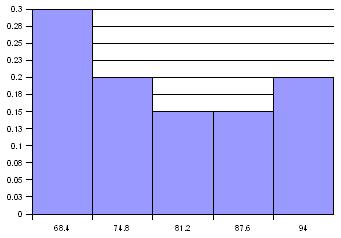| RHR/bpm |
|
|
|
|
| 62 |
|
|
For the resting heart rate data: |
|
| 63 |
|
ratio |
What level of measurement is the data? |
|
| 65 |
|
20 |
Determine the sample size n. |
|
| 68 |
|
76.4 |
Calculate the sample mean x. |
|
| 68 |
|
74.5 |
Determine the median. |
|
| 68 |
|
68 |
Determine the mode. |
|
| 69 |
|
62 |
Determine the minimum. |
|
| 69 |
|
94 |
Determine the maximum. |
|
| 71 |
|
32 |
Calculate the range. |
|
| 72 |
|
10.35 |
Calculate the sample standard deviation sx. |
|
| 77 |
|
0.14 |
Calculate the sample Coefficient of Variation. |
|
| 79 |
|
6.4 |
Determine the class width. Use 5 bins. |
|
| 79 |
|
|

|
| 82 |
|
|
| 83 |
|
|
| 86 |
|
|
| 88 |
|
|
| 91 |
|
|
| 94 |
|
|
| 94 |
|
|
| Bins |
Frequency |
RF |
| 68.4 |
6 |
0.3 |
| 74.8 |
4 |
0.2 |
| 81.2 |
3 |
0.15 |
| 87.6 |
3 |
0.15 |
| 94 |
4 |
0.2 |
| Sums: |
20 |
1 |
|
|
|
Sketch a histogram of the relative frequency |
|
|
|
bimodal |
What is the shape of the distribution? |
|
|
|
0.5 |
p(rhr ≤ 74.8) |
|
|
|
|
Construct a 95% confidence interval |
|
|
|
76.4 |
What is the point est for the pop mean µ? |
|
|
|
19 |
df = _How many degrees of freedom? |
|
|
|
2.09 |
tc = _What is tc? |
|
|
|
4.84 |
The error tolerance E = _______________ |
|
| 71.56 |
≤ µ ≤ |
81.24 |
The 95% confidence interval |
|
|
|
No |
Distringuishable from 72? |
|
|
|
|
Perform a hypothesis test |
|
|
|
|
Ho: µ=72 |
|
|
|
|
H1: µ ≠ 72 |
|
|
|
0.05 |
alpha α |
|
|
|
2.09 |
tc |
|
|
|
1.9 |
The 95% confidence interval |
|
|
|
0.07 |
|
|
|
|
0.93 |
Max c |
|
|
|
|
We fail to reject the null at 5% |
|
|
|
|
5.00% |
|
|
|
|
At α = 0.10 we would reject Ho |
|
| RHR |
BFI |
|
|
|
| 62 |
10.8 |
0.78 |
slope |
|
| 63 |
14.5 |
-35.18 |
intercept |
|
| 65 |
16.4 |
positive |
directionality of correlation |
|
| 68 |
5.5 |
22.77 |
If bpm = 74... |
|
| 68 |
11.7 |
79.41 |
If bfi = 27... |
|
| 68 |
30.5 |
0.696 |
r |
|
| 69 |
11.3 |
moderate |
strength of correlation? |
|
| 69 |
21.7 |
0.48 |
Calculate the coefficient of determination. |
|
| 71 |
23.7 |
48.48% |
What % variation.... |
|
| 72 |
33.5 |
yes |
Relationship between RHR and the BFI? |
|
| 77 |
23.5 |
|
Biologist has a resting heart rate of 49 |
|
| 79 |
20.6 |
No |
Can bfi for the division biologist be predicted? |
|
| 79 |
31.2 |
beyond data |
Why or why not? |
|
| 82 |
17.8 |
|
Is biologist... |
|
| 83 |
45.5 |
Fit |
___ Fit? |
|
| 86 |
34.9 |
|
___ Not fit? |
|
| 88 |
38.1 |
|
___ Not determinable. |
|
| 91 |
21.8 |
|
|
|
| 94 |
34 |
|
|
|
| 94 |
45.9 |
|
|
|

